
Nine pupils won achievement awards for accomplishments in areas ranging from sport to robotics, while teacher Xiangming Xu took a Leader Award both for his dedication in the classroom and for his support of co-curricular activities.
 The awards, which were given by the Jack Petchey Foundation, were given following a selection process open to all QE pupils.
The awards, which were given by the Jack Petchey Foundation, were given following a selection process open to all QE pupils.
Headmaster Neil Enright said: “My congratulations go to the boys and to Xiangming – ten very worthy winners. The award citations reveal strong leadership and great dedication. Furthermore, they reflect the true breadth of the QE experience, which encompasses both academic excellence and our extensive QE Flourish programme.”
The Jack Petchey Achievement Awards recognise outstanding young people aged 11–25 across London and Essex; Leader Awards are given for adults who show exemplary dedication at schools and youth organisations.
The selection process gave QE pupils the opportunity to cast votes: all boys could vote for one pupil and one staff member on two occasions in successive terms.
An awards ceremony took place at the Arts Depot in Barnet.
 Enrichment tutor and Geography teacher Staycie Domzalski said: “It was a lovely opportunity to recognise and celebrate the nine students’ and Mr Xu’s achievements.”
Enrichment tutor and Geography teacher Staycie Domzalski said: “It was a lovely opportunity to recognise and celebrate the nine students’ and Mr Xu’s achievements.”
Each pupil award winner received a certificate, pin badge and a book written by Sir Jack Petchey – a businessman and philanthropist who died last year at the age of 98. They also received a £300 grant for the School, to spend at their own discretion. Similarly, Mr Xu received a £1,000 grant for the School.
The boys chose to spend their grants on equipment including: rugby training tops; VEX robotics hardware; Eton Fives gloves; medical book and DVDs; and badminton shuttlecocks.
Science teacher and form tutor Mr Xu, pictured top, showed “exceptional dedication to both academic and extracurricular life at QE” according to his citation. “…He consistently goes above and beyond –making lessons engaging, helping pupils grasp challenging concepts, and inspiring confidence. He has given up numerous weekends to support students in competitions such as the UKSDC [UK Space Design Competition] and has played a vital role in organising and mentoring teams. His kindness, empathy, and unwavering support make him a true role model, respected not just for his teaching, but for the care and encouragement he shows to every pupil.”
The pupils’ citations were as follows:
Year 10
Soham Bhatnagar: Soham is an exceptional student who consistently leads by example through his dedication, kindness, and strong work ethic. As A team rugby captain and form leader, he inspires others with his resilience, commitment to academics, and support for younger students—both in class and on the coach. Whether mentoring in the gym, attending extra clinics, or simply being a positive presence, Soham embodies the values of leadership, encouragement, and self-improvement, making him a truly deserving candidate for the Jack Petchey Award.
Arhan Panjwani: Arhan is a dedicated and inspiring student whose long-standing commitment to VEX robotics has empowered numerous younger teams through mentorship and support. His selfless guidance, leadership, and contributions across robotics, music, and school clubs make him a true role model in the QE community.
Ayaan Bhat: Ayaan is an exceptional role model whose maturity, kindness, and dedication to helping others shine through in every aspect of school life. As a peer mentor, rugby leader, and active contributor in class and form time, he consistently supports younger students, demonstrates resilience, and inspires those around him with his determination and humility.
Year 11
Jack Tan: Jack is an outstanding role model whose dedication to Eton Fives and support for younger students has made a lasting impact. As a committed captain and mentor, he consistently gives up his time to coach, inspire, and guide others – both on and off the court. His kindness, leadership, and willingness to help with both sport and academics make him a truly deserving recipient of the Jack Petchey Award.
Year 12
Viyath Wanninayaka: Viyath has shown exceptional leadership and generosity by running a challenging and engaging maths club that inspires younger students and stretches their thinking. He is not only highly knowledgeable and hardworking, but also kind, supportive, and always willing to help others – whether it’s giving academic advice or helping classmates with subjects like Latin, Maths, and Science.
Suhaas Sabbella: For being an outstanding leader of the medical ethics club, dedicating significant effort to expanding students’ knowledge beyond the curriculum and enhancing their understanding of medical dilemmas.
Aadam Aslam: For his support during rugby training sessions, both at lunchtime and after school, and for guiding younger students with their GCSE options. Many students find him to be a reliable confidant when it comes to school-related matters.
Year 13
Rayat Ferdous: This student has shown outstanding dedication to the Islamic Society through his consistent leadership in organising daily and Friday prayers, ensuring a respectful and well-maintained space for all students. He gives up his own time every day to set up and restore prayer rooms, supports charitable efforts, and acts as a role model and mentor for younger students. His commitment, humility, and reliability make him a highly deserving recipient of the Jack Petchey Award.
Shaurya Madan: For being an excellent role model and prefect, consistently exhibiting exemplary behaviour and attitude. Many students look up to him and aspire to learn how to improve themselves by following his example.

 His name was announced in front of more than 5,000 international scientists and doctors at the European Human Genetics Conference in Milan.
His name was announced in front of more than 5,000 international scientists and doctors at the European Human Genetics Conference in Milan. The task set for the entrants was: Please, discuss the importance of understanding genetic diversity for health and disease. Support your example with specific DNA variants and genes.
The task set for the entrants was: Please, discuss the importance of understanding genetic diversity for health and disease. Support your example with specific DNA variants and genes. “So next time you hear about a groundbreaking genetic discovery, ask yourself: ‘Who does this benefit, and who’s being left behind?’ Because science should serve all of humanity, not just a select few.”
“So next time you hear about a groundbreaking genetic discovery, ask yourself: ‘Who does this benefit, and who’s being left behind?’ Because science should serve all of humanity, not just a select few.”

 Under the overall theme of International Relations, the 24th edition of the publication includes a special front section headed Has Trump damaged the dollar? which looks at the impact of tariffs and at the dollar’s role as the world’s reserve currency.
Under the overall theme of International Relations, the 24th edition of the publication includes a special front section headed Has Trump damaged the dollar? which looks at the impact of tariffs and at the dollar’s role as the world’s reserve currency. Contributors come from Years 9–11. Many illustrate their articles with tables and graphs.
Contributors come from Years 9–11. Many illustrate their articles with tables and graphs. The awards, which were given by the Jack Petchey Foundation, were given following a selection process open to all QE pupils.
The awards, which were given by the Jack Petchey Foundation, were given following a selection process open to all QE pupils. Enrichment tutor and Geography teacher Staycie Domzalski said: “It was a lovely opportunity to recognise and celebrate the nine students’ and Mr Xu’s achievements.”
Enrichment tutor and Geography teacher Staycie Domzalski said: “It was a lovely opportunity to recognise and celebrate the nine students’ and Mr Xu’s achievements.”
 His winning project, Icarus, is a decentralised telecommunication system designed for low-cost and effective emergency communications in remote areas: it was inspired by his love of the outdoors and of trekking.
His winning project, Icarus, is a decentralised telecommunication system designed for low-cost and effective emergency communications in remote areas: it was inspired by his love of the outdoors and of trekking. Icarus uses a custom Meshtastic PCB based on ESP32-S3 N8R8, L76K GPS and LoRa RA-01SH, designed to be fully assembled by the online PCB service provider, JLCPCB.
Icarus uses a custom Meshtastic PCB based on ESP32-S3 N8R8, L76K GPS and LoRa RA-01SH, designed to be fully assembled by the online PCB service provider, JLCPCB.
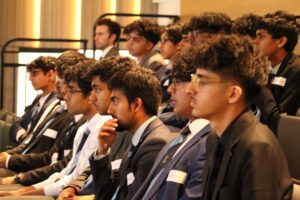 The one-day event gave pupils the chance to hear from leading doctors across a range of specialisms – several of whom are involved in medical research – and to talk to current medical students.
The one-day event gave pupils the chance to hear from leading doctors across a range of specialisms – several of whom are involved in medical research – and to talk to current medical students.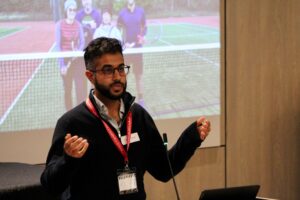 “This was achieved through a series of insightful talks delivered by some of the most inspiring doctors and medical students we could have asked for, followed by a vibrant networking session in our atrium.”
“This was achieved through a series of insightful talks delivered by some of the most inspiring doctors and medical students we could have asked for, followed by a vibrant networking session in our atrium.”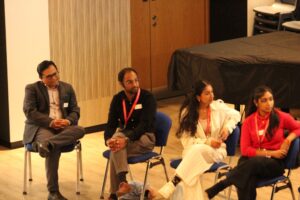 Dr Jayanta Banerjee – Neonatal consultant (St Mary’s Hospital, Imperial College Healthcare NHS Trust)
Dr Jayanta Banerjee – Neonatal consultant (St Mary’s Hospital, Imperial College Healthcare NHS Trust)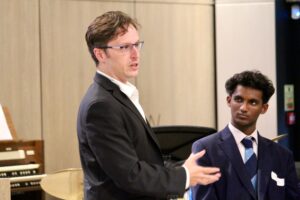 Soham added: “Organising and hosting this event was a huge learning experience. From coordinating speakers and logistics to dealing with last-moment changes under pressure, it has pushed me to grow as both a team-player and a communicator. It also reaffirmed my passion for Medicine – not just as a career, but as a field built on human connection and constant learning.”
Soham added: “Organising and hosting this event was a huge learning experience. From coordinating speakers and logistics to dealing with last-moment changes under pressure, it has pushed me to grow as both a team-player and a communicator. It also reaffirmed my passion for Medicine – not just as a career, but as a field built on human connection and constant learning.”
 Although entrants compete as individuals, they are placed in national teams. Harik was part of a five-strong UK team, all of whom won medals. Three took bronze, while one was another silver winner, albeit with a lower score and ranking than Harik’s. Medals were awarded to the top 208 competitors.
Although entrants compete as individuals, they are placed in national teams. Harik was part of a five-strong UK team, all of whom won medals. Three took bronze, while one was another silver winner, albeit with a lower score and ranking than Harik’s. Medals were awarded to the top 208 competitors.